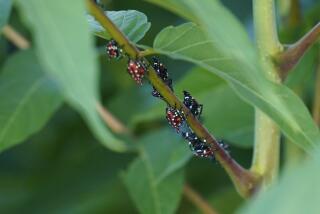GROWING GRAPES
- Share via
Grapes are one of the oldest fruits known to mankind, and every climate will support at least one or two varieties. Despite the long and proven history of grapes as a productive garden and commercial crop, most home gardeners avoid dealing with them because of the attendant pest and disease problems, which they believe are difficult to deal with. Given the right cultural attention--and a watchful eye on pests--grapes can be grown and enjoyed by all.
The primary cause of failure in the home vineyard is the choice of a variety that is not suited for a particular location or climate. In cool, foggy situations along the coast, most varieties do no ripen well. Only the Concord, Niagara, Golden Muscat, Isabella and a few other slip-skin American varieties ripen properly in such areas. Seedless varieties, as well as most European types, need hotter summer locations. Ribier, Malaga and Tokays are most at home in our warm valleys. Regardless, all grapes do better where they get abundant sunshine.
As they mature, grapevines need training to concentrate fruit growth and facilitate care. European varieties--such as Cardinal, Muscat, Ribier and Malaga--need more-severe pruning and are best grown on a single wire strung three to four feet above the ground. Arbor or trellis training should be reserved for American varieties or their hybrids such as the Concord, Golden Muscat or Niagara.
Grapes are borne on the canes that grew during the previous summer. Canes of most varieties should be pruned back to the buds each year. Only Thompson seedless, Concord, Olivette and Niagara require longer canes to produce good crops. When vines are young, remove any sucker growth or water sprouts during the summer, but do so with care.
The most common pests found in the vineyard are mildew and the grape leaf-hopper. As is the case with most pests, the degree of damage they do depends on the precise location, the weather, the abundance of naturally occurring parasites and predators, and the vitality of the vine.
Mildew is a particularly devastating disease. It attacks all green parts of the vine, including unripe grapes. When neglected, it causes curling and withering of the leaves and discoloring of the berries. Preventive control requires thorough dusting of all surfaces with sulfur. Vines should be treated when new shoots are six inches long and again when they measure 12 and 18 inches. Wettable sulfur should be used when the mildew disease is already evident.
Leaf-hoppers cause pale stippling on upper leaf surfaces; this turns into bleached-out areas until the leaf dies. If chemical control is needed, use malathion.
get the answers Q: Two of the canes of my Chamaedorea palm have died. The rest of the plant looks good. What could the problem be? --W.T., Temple City A: A fungus that can enter Chamaedorea palms can cause the death of one or more canes. Usually, infection occurs as result of a wound in the cane. Even the act of tearing off a frond can create a wound through which the fungus can enter. Take care not to provide entryways for the fungus and the problem will probably not reoccur.
Q: I’ve heard that pesticides used in the garden can kill honeybees. Is there any way I can use pesticides safely? The pests really wipe out some of my plants. --R.T., Rowland Heights A: University of California scientists suggest applying the pesticide very early in the morning. That allows the spray to dry off before bee activity begins.
Q: Last year, my family and I tried our hand at budding and grafting our own fruit trees. All is well except that the young trunks are bent, not straight. Why is that? --D.H., Los Angeles A: The problem of jointed trunks is the result of frequent changes in the weather: growth stops and starts and you get “jointed” trees. If the weather is consistent throughout the growth season, the trees grow quickly and straight.
Q: What would cause my fruit trees to bleed from their trunks every spring? Is it an insect? --T.C., Fullerton A: Bleeding--or gummosis--indicates that something is wrong, the way a fever indicates a health problem in a human. Dozens of conditions could cause the bleeding. Cold weather followed by warm weather make the symptom more apparent. Mechanical injury or insect attack are only two of the possible causes.
Q: A friend has offered me some “pups” from her mature staghorn fern. How should they be handled after I’ve removed them from the mother fern? --O.P., Newport Beach A: Plant the offshoots in pots that contain a mixture of peat and sphagnum moss. Remember, a staghorn is a slow grower, so size will not come quickly. They also require a minimum of water, even during the heat of summer.
Questions will be answered only when a self-addressed stamped envelope is enclosed. Write to the Garden Doctor, Home magazine, Los Angeles Times, Times Mirror Square, Los Angeles 90053. Please allow at least six weeks for a reply. Plant specimens sent for determination of trouble should be wrapped and enclosed in an envelope. Boxes are not accepted.






